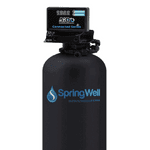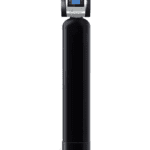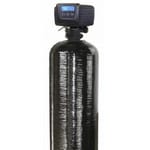An iron filter won’t rock your world, but it will drastically change how you feel about your water. If your tap is off limits, and you’re spending more on appliance repairs than vacations, iron could be to blame.
It clogs up plumbing, ruins water heaters and makes coffee taste like metal. Resistant to the usual filtration methods, you need more than carbon to remove it. So let’s compare different filters for removing iron from well water
Our Picks:
- Best overall: SpringWell WS
- Best For High Iron: Softpro Iron Master
- Best For Bacteria: Pentair
- Best in Capacity: AquaOx
- Best For Sulfur: Tier 1
- Best Chemical System: Crystal Quest
- Best Budget: Durawater Iron Eater
#1 SpringWell WS Whole House Well Water Filter System
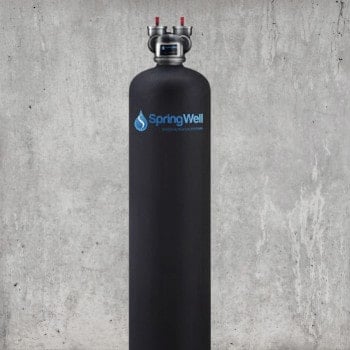
SpringWell’s whole house filtration system tackles tough iron problems. Say goodbye to orange stains and rotten egg odor. Contaminants including iron, manganese and hydrogen sulfide are oxidized and filtered in a single tank.
Your water will look, smell and taste like nature intended.
- Comprehensive iron filtration
- Maintenance-free
- Environmentally friendly
- Straightforward DIY installation
- Easy bathroom-based sizing
Use Coupon Code: QWL5 to save
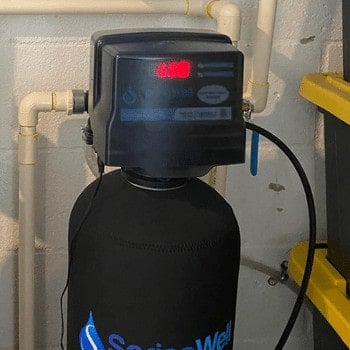
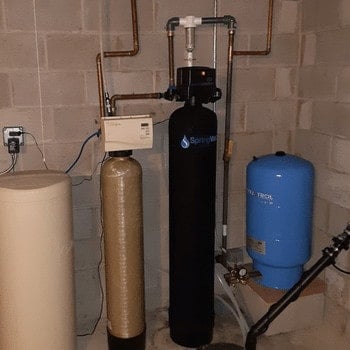
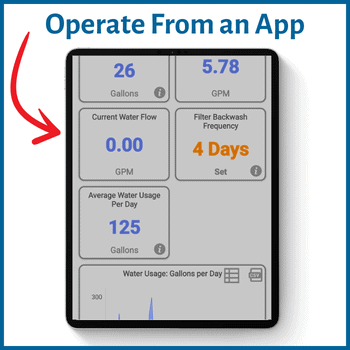
Best For: Those looking for the best of the best whole house water filtration system for iron that just works at knocking out high levels of iron efficiently need this system.
Not Best For: If budget is an issue, I would lean towards Softpro AIO system.
Pros
- Enjoy the peace of a whisper-quiet system.
- Easily manage settings via Bluetooth, either from the digital head or your handheld device.
- Intelligent backwashing based on water usage minimizes wastewater, saving you cash.
- Experience consistent water pressure with a flow rate that outperforms many competitors.
- Installation is straightforward for those with basic plumbing know-how. If that’s not you, a professional can handle it with ease.
- The self-cleaning filter is built to last, ensuring longevity as long as the filtration media remains effective.
- Efficiently tackles up to 7 PPM of iron, 1 PPM of manganese, and 8 PPM of hydrogen sulfide, outdoing many rivals.
- Designed to be a one-time investment, its upfront cost is balanced by minimal maintenance expenses.
- Crafted from high-quality, certified materials, its robustness is palpable. Trust in a product backed by a company with decades of filtration expertise.
- Lifetime warranty offers peace of mind.
Cons
- Fittings sold separately.
- Components on the head are plastic, which many systems are. It would be nice if they were metal.
What Others Have Said:
“Stuart E said on 4/17/23: We had terrible iron content in the water. This system made an immediate difference in the quality of the water. I would advise not to buy any fittings until your actual unit arrives though. The instructions and video show the spin-down filter being threaded, but mine is not threaded. So I had to return the 1″ NPT nipples I bought and use solvent Read more about review stating Excellent
cement and PVC fittings to connect the spin-down filter to the system. Not a negative on the product, but I should have waited until it arrived to buy parts. I would still recommend this system to anyone with well water.”

SpringWell Product Updates:
- SpringWell now offer filtration for 4+ bathrooms
- Optional UV add-on
- Optional Reverse osmosis upgrade.
#2 SoftPro Iron Master AIO Well Water Iron Filter
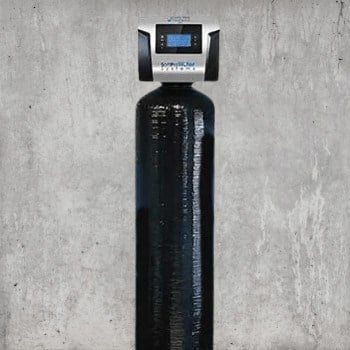
The IronMaster filtration system crushes iron without chemicals — up to 30 PPM, the highest in the industry. Available in three sizes to match your well’s flow rate, choose the model that best fits your home without overpaying for a too-large filter.
- Low upfront cost
- Flexible sizing
- Handles the worst iron problems
- Removes hydrogen sulfide and manganese
- Limited lifetime warranty
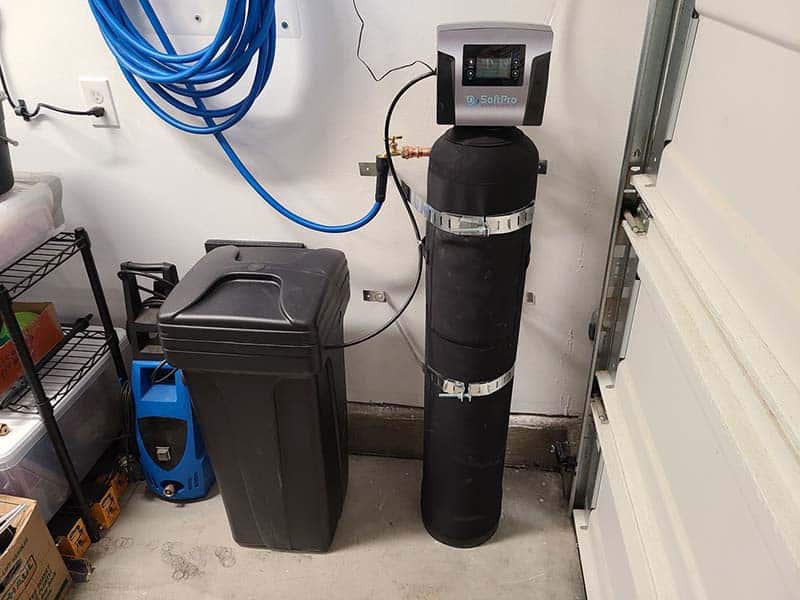
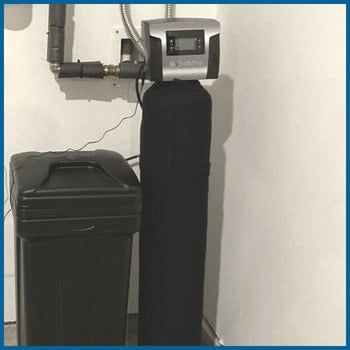
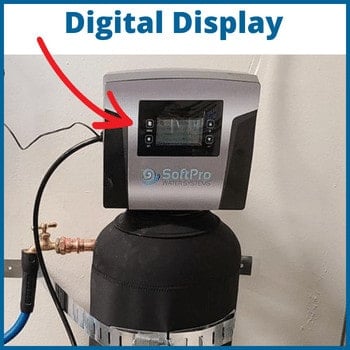
Best For: This system is perfect for those looking to knock high levels of iron without the bells and whistles.
Not Best For: Those looking for remote app capability.
Pros
- From our research, the IronMaster’s digital head stands out. It’s straightforward, giving you a clear snapshot of the system’s status without any fuss.
- Another thing we appreciate? It’s assembled in the US. That speaks volumes about its durability and the quality of components they’re using.
- Now, if you’re dealing with some serious iron issues in your water, this system seems up to the task. It’s designed to tackle even the most stubborn iron problems.
- A point worth noting: while its build quality is top-notch, and many users vouch for its performance, it might need a bit more maintenance compared to some other systems out there. But given its price point, it’s still a solid choice, especially if you’re dealing with iron levels greater than 10 PPM.
- A little pro tip from our side: consider installing a sediment prefilter. It might help the main filter last longer and keep things running smoothly.
- On the installation front, it seems pretty straightforward. They’ve included essentials like a bypass valve and a quick-connect hose kit, which should make the process smoother.
- Lastly, in terms of water pressure – something we all care about – the IronMaster doesn’t disappoint. Its flow rates are above average, ensuring you won’t be left waiting for that shower to heat up.
Cons
- Requires more maintenance than similar systems.
- The system is not effective at removing all contaminants from your water.
- If your water is highly contaminated with iron, you may need to replace the redox filter media more frequently.
What Others Have Said:
“Evelyn (and Brian) R. said on 10/07/23: If you have high iron and iron bacteria don’t hesitate: BUY THIS ! I know my pictures look a bit messy but that really doesn’t matter to me. This filter is the greatest. It was so easy to put in even in my tiny cramped outdoor pump house. I did it by myself in about an hour if you don’t count the time for pvc glue curing, and I’m a 54 test old woman and an RN not a plumber.
I have both types of iron and iron bacteria in my well water. I had been using big blues with sediment, carbon, KDF filters and it was tolerable but didn’t take care of the iron bacteria. Now my horrible brown iron filled water problem is fixed, and the smell is gone. My water is crystal clear, and I’m so pleased with this product.”
Product Updates:
- Upgraded valve to 1″ to provide more water-flow
#3 Pentair Iron and Manganese Water Filter
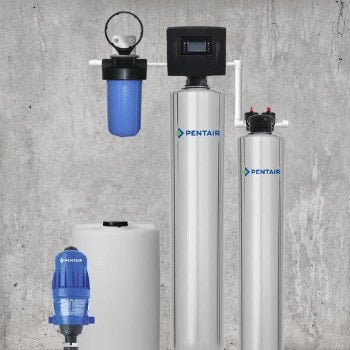
Pentair’s well water iron filter is a four-stage, chlorine injection system that not only removes iron but also makes water potable.
It comes complete with a sediment filter that enhances its efficiency, plus a premium block carbon filter that removes chlorine and more. Water is as fresh-tasting as bottled.
- High-capacity
- Safety-certified
- Won’t reduce water pressure
- Durable components
- 60-day satisfaction guarantee
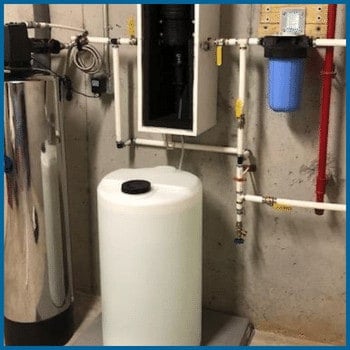
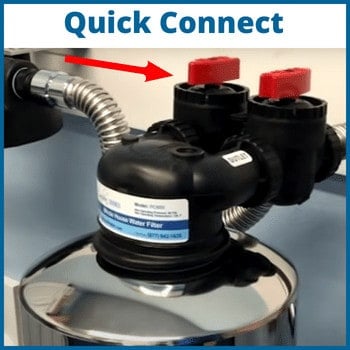
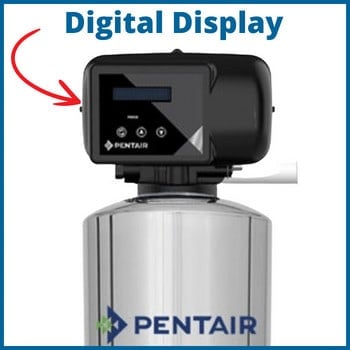
Best for: For some wells, an iron filter isn’t enough. If you also have bacteria or chemicals in your water that make it unsafe to drink, the Pentair is the solution you’ve been looking for.
Not best for: Those that are on a budget as this system is very expensive.
Pros
- Septic-safe, the system processes up to a million gallons of water with minimal maintenance. Programming is highly intuitive.
- NSF 42 certified, the Pentair received the Water Quality Association’s (WQA) seal of approval and is priced well below similar iron water filters sold by other leading manufacturers.
- The multi-stage filtration eliminates a wide range of contaminants.
- Few iron filters for well water offer this level of protection for such a modest investment.
- Pentair filters are guaranteed to reduce chlorine to undetectable levels for five years, or they’ll replace the carbon filter for free.
Cons:
- Installation is complex if you’re not handy, and the warranty gives us a headache — each part from tanks to tubing is covered for a different length of time.
Product Updates:
- Pentair now offers the WF10-P for larger homes with up to 6 bathrooms
#4 AquaOx FE Edition Well Water Iron Filter
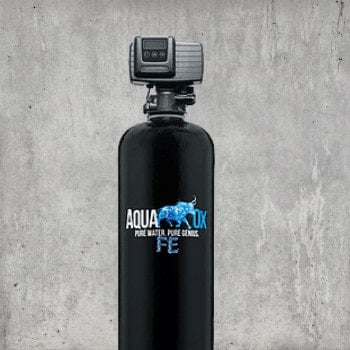
AquaOx’s iron reduction system is a new take on its highly regarded whole home filtration system. A Birm filter, its aluminum-enhanced media oxidizes and reliably removes up to 7 PPM of iron.
It has a two-million gallon capacity — enough for a family of four for a decade or more with no costly filters to replace.
- Huge capacity
- Maintenance-free
- 12 GPM flow rate
- American-made
- Elite 10-year warranty
Best for: Those looking for a system that just performs with the least amount of maintenance.
Not best for: If you’re tight on budget, I would lean towards Softpro or SpringWell that have similar capabilities at a better price.
Pros
- A breeze to install and maintenance-free, the AquaOx FE edition is brought to you by a veteran-owned, South Carolina-based company.
- If it doesn’t perform as expected, you’re protected by a 12-month money-back guarantee and their dedication to customer service.
- AquaOx consistently earns five-star reviews for its thoughtful engineering, and this filter is no exception.
- Built to last, its beauty lies in its simplicity — just set it and forget it.
- Gallon for gallon, no filter removes more iron for the money.
- If you want to spend more time enjoying clean water than thinking about it, consider the AquaOx.
- A prefilter is not required, but it will likely improve your overall water quality and protect your investment.
Cons
- Not recommended for well water with tannins
AquaOx Product Updates:
- Now includes a pre-sediment filter.
#5 Tier 1 Whole House Iron Filter
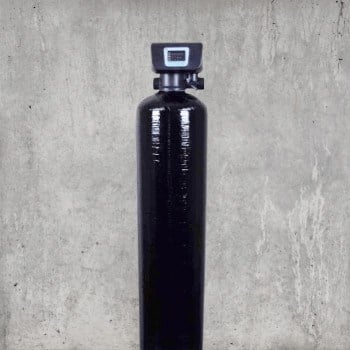
Tier 1’s Precision Series air induction filters reduce up to 30 PPM of iron plus hydrogen sulfide and manganese, ridding your home of unsightly stains and rotten egg smells without chemicals.
From your shower to your kitchen faucet, every gallon is crystal clear.
- Handles the most stubborn iron problems
- Low upfront price
- Space-saving footprint
- Operates quietly

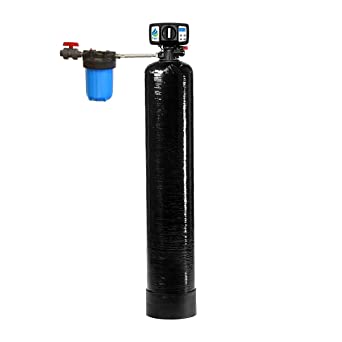

Best for: This is a great system for those looking to save money and eliminate iron.
Not best for: Those with low water pressure and tannin issues will want to stay away from this system.
Pros
- The electronic control meter is a cinch to program — there are no confusing codes or symbols.
- It monitors your water usage and displays the gallons remaining until regeneration.
- Cycles are fully adjustable, and the battery backup saves your settings if the power goes out.
- This budget-friendly system lasts up to 60 months with minimal maintenance and includes a protective sediment filter.
- Non-electronic parts are warrantied for ten years.
- Iron reduction filters are more efficient with high-pH water, so Teir1 incorporated calcium and magnesium into their filtration media to condition acidic water as it flows through the system, raising its pH.
- The system is designed for 1-6 people, yet the flow rate is lower than average at 5.8 GPM.
- You’ll have to replace it sooner than other models, but it’s among the lowest priced iron filters for water with levels exceeding 10 PPM.
- Ideal for the iron-weary homeowner with an equally exhausted checkbook, it’s a good value.
Cons
- Not recommended for water with tannins
- Under heavy use, you may notice a minor drop in water pressure.
Product Updates:
- Now includes an NSF certified electronic head valve
#6 Crystal Quest Whole House Iron Filter
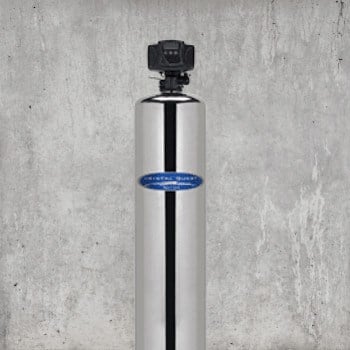
Crystal Quest’s well water iron filters boast impressive three-stage filtration that removes sediment, agricultural chemicals, industrial solvents, iron, manganese, hydrogen sulfide and more.
Expandable, you can add a softener, UV sterilizer and SMART filter that removes even more toxins, including heavy metals. Choose fiberglass tanks or upgrade to stainless steel.
- Quality filtration
- Won’t reduce water pressure
- Minimal maintenance
- Premium components
- Expandable
Best for: Those looking to eliminate 12PPM of iron from their well water efficiently.
Not best for: Those that want a system that’s more hands-free and less technical to operate.
Pros
- Available in two sizes depending on your water usage, the 9-13 GMP flow rate provides ample water pressure.
- Systems treat up to a million gallons depending on your water quality, but Crystal Quest recommends changing the media every 5-7 years for optimal performance.
- If you have a water problem, Crystal Quest can fix it. Their expandable iron filter removes more contaminants than similar models. But more isn’t better for everyone.
- For homeowners who want a broader level of protection, the specs are impressive. It’s a solid choice for well water with other dangerous contaminants.
Cons
- A complex system, professional installation is warranted but costly. And it’s not particularly user-friendly — an entire page of the instruction manual is devoted to explaining the acronyms used to program the control valve. If you just want a water filter for iron, it’s overkill.
- Short one-year warranty
- Confusing user interface
Product Updates:
- Nothing to report, yet.
#7 Durawater Air Injection Iron Eater Filter
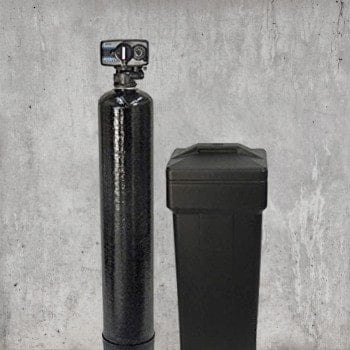
Durawater’s Iron Eater is a simple, low-budget approach to iron filtration. It removes up to 12 PPM of iron plus sulfur and manganese. An air injection system, it works without chemicals, oxidizing and filtering contaminants in a single fiberglass tank.
- Low initial cost
- Chemical-free
- Low-maintenance
- Minimal maintenance
- Outstanding customer service
Best for: Anyone looking to save money on a system that just works.
Not best for: Those looking for a quiet running system and one with app based control and monitoring won’t like this system.
Pros
- Equipped with a Fleck 5600SXT control head, the most advanced on the market, it’s remarkably simple to program.
- Change the media every 5-7 years for the best performance — $200 at current prices.
- It removes more hydrogen sulfide than many filters — up to 10 PPM.
- The system schedule is fully programmable. Air injection filters can be loud, so we recommend backwashing when the sound is least likely to be disturbing.
- It comes with a battery backup, so no need to worry if you lose power.
- It won’t win awards for style, but it’s a solid, easy-to-install system that does a capable job cleaning up iron, manganese and sulfur for less.
Cons
- Loud operation.
Product Updates:
- Nothing to report, yet.
Comparison Table
(Mobile users: Swipe to scroll) Compare Brands & Models
Compare Brands & Models
|
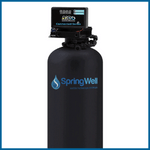 #1 SpringWell WS Filter
#1 SpringWell WS Filter |
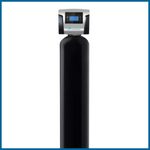 #2 SoftPro Iron Master
#2 SoftPro Iron Master |
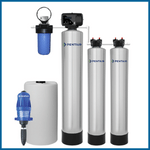 #3 Pentair Iron & Manganese
#3 Pentair Iron & Manganese |
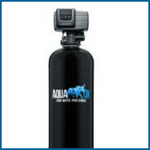 #4 AquaOx FE Edition #4 AquaOx FE Edition |
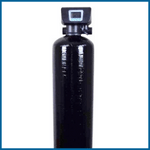 #5 Tier 1 Iron Filter System #5 Tier 1 Iron Filter System |
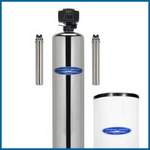 #6 Crystal Quest Filter
#6 Crystal Quest Filter |
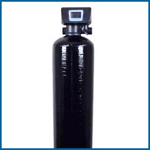 #7 DuraWater Iron Filter
#7 DuraWater Iron Filter |
|---|---|---|---|---|---|---|---|
| Rating | 5/5 | 5/5 | 4.5/5 | 4.5/5 | 4.5/5 | 4.5/5 | 4.5/5 |
| Price | $$$ | $$$ | $$$$ | $$$$ | $$ | $$$ | $$ |
| Iron Type | Ferrous + Ferric | Ferrous + Ferric | Ferrous + Ferric + Bacteria | Ferric | Ferrous + Ferric | Ferrous + Ferric | Ferrous + Ferric |
| Max Fe | 7 PPM | 30 PPM | 10 PPM | 7 PPM | 30 PPM | 12 PPM | 12 PPM |
| Process | AIO + Greensand | AIO + Katalox | Bleach Oxidation + Greensand + Carbon Filter | AIO | AIO | AIO | AIO |
| Flow Rate | 12-20 GPM | 12 GPM | 7 GPM | 6-12 GPM | 6 GPM | 6-12 GPM | 6-12 GPM |
| BlueTooth | ✔️ | ❌ | ❌ | ❌ | ❌ | ❌ | 4.5/5 |
| Warranty | Lifetime | 7 years | 1 year | 10 year | Lifetime limited | 7 years | 10 years |
How We Chose

We get it. Diving into the world of water filtration can feel like you’re navigating a maze without a map. But here’s the good news: you’re not alone on this journey. With over a decade of hands-on experience in water filtration, think of us as your seasoned guide, ready to help you sidestep the pitfalls and jargon.
Our methodology is rooted in seven pivotal criteria, each weighted to reflect its significance:
- Iron Reduction (20%): The primary objective of an iron filter is to diminish iron content. Seek a system adept at eliminating both ferrous (dissolved) and ferric (insoluble) iron.
- Flow Rate (15%): Ensure your chosen system aligns with or surpasses your household’s water usage, without compromising performance or water pressure.
- Capacity (15%): Denotes the total water volume a filter can process before necessitating replacements. Opt for a system that resonates with your daily water usage.
- Filter Media (15%): Various filtration media cater to specific iron contaminants. Popular choices encompass activated carbon, KDF-85/GAC blend, greensand plus, and birm media. Your selection should align with your well water’s iron composition.
- Installation (10%): While many entrust installation to professionals, DIY enthusiasts will appreciate systems complemented by comprehensive guides and video tutorials.
- Maintenance (15%): A user-friendly maintenance routine is crucial. Understand the upkeep schedule and gauge if it’s manageable without professional intervention.
- Cost Implications (10%): Beyond the initial investment, factor in recurring expenses like energy consumption and filter replacements.
At the end of the day, we’re not just here to point you to a product. We genuinely want you to feel good about your choice, every single time you use that tap. To ensure you’re getting the real deal, we’ve gone the extra mile, diving deep into online reviews and spotlighting any potential hiccups with certain systems. Your trust means the world to us, and we’re here to safeguard it.
Buyer’s guide

Iron isn’t a health hazard, but it’s a homewrecker. It makes water taste bad and wreaks havoc on plumbing, appliances and bathroom fixtures, taking a bite out of your budget with needless repairs.
The straightforward solution is filtration, yet iron filters for well water aren’t well understood.
Join us as we discuss the technology, decipher the jargon, and consider their features. Together, we’ll choose the best iron water filter for your home.
In this guide, you’ll learn:
- How we picked these systems
- Key considerations to know before you buy
- Why water testing is important
- How to choose the right system
- What is iron
- FAQ’s
Advantages & Disadvantages

Advantages:
- Whole house iron filters are incredibly useful for reducing Iron, Manganese and Sulfur in your water supply, eliminating odors, staining and corrosion from plumbing systems.
- We only recommend systems that are easy to install, operate and maintain over the long-term.
- These cost-effective solutions require minimal maintenance and can last up to 10 years with proper care.
- The filter media used is highly efficient at removing contaminants without clogging quickly or needing frequent replacement like other types of filters do.
Disadvantages:
- It’s important to understand what type of iron you need removed and how much the type/brand you choose can do this as an iron filter may not remove all traces of iron in a perfect world scenario .
- Some models may require additional components such as an air injector system which adds extra costs upfront when purchasing the unit itself as well as ongoing expenses for electricity usage during operation (depending on how often you use it).
- Over time, the filter media used in these systems can become clogged reducing its effectiveness and requiring more frequent replacement .
- Lastly, these systems may not be able to remove other contaminants such as bacteria or viruses from your well water, so additional filtration methods may need to be employed if this is a concern.
Before You Buy

Things to Consider:
1. Test Your Water: Before anything else, determine your water’s iron levels and other contaminants. This will directly influence your choice of filtration system.
2. Budget Wisely: Consider both the initial cost and long-term maintenance. Sometimes, spending a bit more upfront can save you in the long run.
3. Space & Installation: Assess the space you have available for installation. Some systems might be too large for your setup. Decide if you’re comfortable with DIY installation or if you’ll need professional help.
4. Maintenance & Longevity: Check how often parts or media need replacement. A system that requires frequent maintenance might not be the best choice for everyone.
5. Reviews & Warranty: Look at user reviews for real-world insights and ensure the product comes with a solid warranty.
Remember, the right iron filter can make a world of difference. Take the time to research and choose wisely!
Filtration Options
The best iron filter for your needs is one that removes the type of iron you have and is compatible with your water’s chemistry. We want you to learn about the benefits of using an iron filter for well water.
Let’s narrow them down.
If your water contains only ferric iron — particles that float in your water but don’t turn it brown — a sediment filter may be all you need. Choose from sediment-only filters to multi-stage systems that remove other unwanted contaminants.
If you have iron bacteria in your water, your filtration choices are limited to:
- A chlorine injector
- A catalytic carbon and hydrogen peroxide filter
- An ozone filtration system
For all but the most stubborn iron problems, chlorine injectors are the least expensive to purchase and maintain. Add a carbon post-filter to resolve the chlorine taste.
If the total iron content in your water is less than two ppm, consider:
- A sediment prefilter and water softener
- Any oxidizing iron filter that works with your water’s chemistry
For total iron content greater than two ppm, choose:
- Any iron filter rated for two ppm or more
Now, consider how these additional factors impact your purchase.
Contaminant Filtration Capability
Iron filters primarily target, well, iron. But iron often brings along some unwelcome pals: manganese and hydrogen sulfide. If you’ve spotted black stains on your bathroom fixtures, that’s manganese at work. And that rotten egg smell? Blame hydrogen sulfide.
While oxidation is the go-to method for tackling hydrogen sulfide and manganese, not all iron filters handle both. Birm filters, for instance, are the odd ones out. But if you’re dealing with iron bacteria, chlorine filters are your best bet.
And hey, sometimes water tests can throw curveballs with unexpected contaminants. The key? Find a filter (or a combo) that tackles as many issues as possible without breaking the bank. It’s all about getting the most bang for your buck.
Footprint
Iron filters come in different shapes and sizes. The single-tank ones? They’re tall, almost like your water softener, standing proud at about five feet. You’ll usually find them in basements or garages. But if you’re thinking of squeezing them into a crawlspace, think again.
Opting for a multi-tank system? They demand more space, up to 16 square feet. And trust us, you’ll want some elbow room for maintenance tasks. Always double-check the dimensions before making a purchase.
Flow Rate
Here’s the deal: filtration isn’t instant. Each filter layer the water passes through can slow things down a tad. And a slow flow rate? That’s the culprit behind that frustrating drop in water pressure.
Flow rate, in simple terms, is how much water your filter can handle per minute. In the U.S., households can use a lot of water, especially when multiple appliances are running. So, a top-notch iron filter should keep pace without making you wait.
System Size
Remember the days when water softeners and iron filters had confusing sizing methods? Thankfully, manufacturers have shifted to a more user-friendly approach, sizing based on the number of bathrooms in your home. Just stick to the guidelines, and you’re golden.
Capacity & Filter Life
Capacity is all about endurance: how many gallons your filter can handle before it needs a refresh. It’s crucial to weigh this against the system’s overall cost. A cheap filter that’s high-maintenance? That’s not a deal; it’s a headache.
Installation & Maintenance
Setting up an iron filter isn’t some complex puzzle. With a bit of plumbing knowledge and the right tools, it’s a DIY task. Many sellers even offer guidance through calls or handy online videos. But if DIY isn’t your thing or your home poses unique challenges, getting a professional onboard is a smart move. After all, peace of mind is priceless.
Warranties
Iron water filters aren’t cheap, so warranties are a significant selling point. They range from a year to a lifetime, covering repair bills when you can least afford them.
Some companies require professional installation of the iron removal system and recommended prefilters, or the warranty is void. And shipping the filter back to the manufacturer for repairs may be on your dime. Know the terms before you buy.
No warranty covers:
- Normal wear and tear
- Improper handling or installation
- Illegal use
- Damage to your home as a result of a malfunction
What Is Iron?
Iron is an element found in the Earth’s crust. Useful in products from frying pans to furnaces, it’s everywhere around you in the rock and soil. Virtually all groundwater has some iron in it. The amount and type determine what kind of iron water filter you need.
How Does Iron Get into Your Water?
Iron seeps into well water from the soil. Every time it rains, water flowing over rock carries iron deep into underground aquifers. The deeper your well, the more iron it’s likely to contain.
Is Iron in Well Water Dangerous for Your Health?

Low levels of iron aren’t considered harmful, but the EPA classifies it as a secondary contaminant because it can harbor iron bacteria — microorganisms that feed on dissolved iron. Alone, they rarely cause illness, but they create conditions under which dangerous bacteria can grow.
How much iron is too much? Levels above three parts per million (PPM) can cause skin irritation. It prevents soap from lathering effectively, creating a sticky residue that clings to hair and clogs pores. The effects range from dryness to oily rashes.
And although it’s not a direct danger, excessive iron affects how water looks, smells and tastes. Drinking less water because you don’t trust what’s coming from your tap is no bargain for your health.
There is one medical condition that iron in water can exacerbate. Called hemochromatosis, it’s an iron build-up in the body caused by a faulty gene. Serious, it affects about a million people in the US, causing heart and liver disease. Talk to your doctor about iron filtration if it runs in your family.
Effects of Iron
The effects of excessive iron are insidious — they’re gradual and cumulative. Unless the water is rusty, the damage is often done by the time homeowners notice. Early treatment is critical.
The consequences of too much iron include:
- Low Water Pressure:
- Iron accumulated in pipes eventually narrows their diameter, so water can’t flow freely. The first symptom is low water pressure. Over time, it prevents the passage of solid waste, causing clogs.
- Damaged Appliances:
- Water-using appliances, from dishwashers to water heaters, rely on adequate water flow. Low pressure forces them to work harder, leading to higher utility bills. Iron slime on delicate parts is corrosive, causing premature breakdowns. Replacing an electric water heater can cost more than $1000!
- Stained Clothing, Dishes and Bathroom Fixtures
- The same red slime that iron bacteria leaves in your pipes also ends up in your washing machine and dishwasher where it leaves hard-to-remove stains on clothing and dinnerware. It coats toilets, tubs and shower walls. Miss a day’s cleaning, and it can permanently discolor grout and tile.
Can Iron Be Removed from Water Naturally?
Filtration is the only reliable way to remove iron, but some filters are chemical-free and use more natural means than others.
How Do Iron Filters Work?
Iron filters are like the superheroes of water purification. They use a mix of techniques to tackle the pesky iron in your water. Here’s a quick breakdown:
- Sediment Filtration
- Think of this as a net catching big rust particles. Great for catching ferric iron, but not so much for its sneaky cousin, ferrous iron, or those pesky iron bacteria.
- Ion Exchange
- This is the same trick water softeners use. Imagine iron sticking to tiny beads as water flows. Sounds great, right? But in real life, it’s a bit picky. It only tackles ferrous iron and needs everything to be just right to work well. If you’ve got tannins in your water, you’ll need an extra filter.
- Oxidation and Filtration
- This method turns ferrous iron into ferric iron and then filters it out. It’s like turning a sneaky ninja into a slow-moving zombie that’s easy to catch. Different filters have their own quirks:
- Birm: Uses oxygen in water. Effective, but needs the right conditions.
- Manganese Greensand: A popular choice that tackles tough iron issues but uses a chemical some folks aren’t fans of.
- Chlorine: Old but gold. It’s been used for ages and also makes water safe to drink. But, it might leave a chemical taste.
- Aeration: Uses air to change ferrous to ferric iron. Eco-friendly but produces more wastewater.
- Catalytic Carbon & Hydrogen Peroxide: A dynamic duo that’s effective but a bit pricey.
- Ozone: Super powerful but comes with a hefty price tag and potential health concerns.
- KDF: Great for showers and multi-stage filters.
- Katalox: A new kid on the block that’s efficient and long-lasting but doesn’t tackle iron bacteria.
- This method turns ferrous iron into ferric iron and then filters it out. It’s like turning a sneaky ninja into a slow-moving zombie that’s easy to catch. Different filters have their own quirks:
Remember, the best filter for you depends on your specific water issues and needs. It’s all about finding the right superhero for your water woes!
Whole-Home Vs Point-of-Use Filters for Iron Removal
There are two types of water filtration systems – whole-house filters that treat water as it enters your home and point-of-use filters that treat water from a single tap.
Point-of-use systems, such as countertop filters or filtration pitchers, can reduce particles of ferric iron in your drinking water, but they can’t remove ferrous iron or iron bacteria, leaving your health, plumbing and appliances at risk. The only practical solution is a whole-house filter.
Was This Page Helpful? Email us: [email protected]
Frequently Asked Questions:

Most water softeners can remove 1-2 ppm of ferrous iron, but ferric iron, tannins, hydrogen sulfide, and a pH above 6.5 impair their efficiency. Unless you need to both soften water and remove low levels of iron, a dedicated iron filter is usually a better option
RO filters can remove iron, but they’re not recommended. Any more than 0.3 ppm will permanently ruin the membrane.
Iron filters are very effective within their specifications. Be sure to test your iron levels to choose the best system for your needs.
Air injection filters are not only effective, but they’re also chemical-free. Drawbacks include a clicking noise when the injector is working, and they’re not recommended for wells with iron bacteria. The extra oxygen helps it bloom.
Iron Curtain water filters are chemical-free oxidizing filters that remove iron both iron and hydrogen sulfide. Made by Hellenbrand, they’re sold by better water treatment companies and come in one-, two- and three-tank configurations based on the severity of your iron problem.
Sediment filters remove ferric iron – small but solid particles of rust. They don’t remove dissolved iron or kill iron bacteria.
Rust is ferric iron, so a sediment filter may be all you need. High levels, however, may clog them prematurely. An iron filter may be a better long-term solution.
 115 people found this helpful. Was this guide helpful to you?
115 people found this helpful. Was this guide helpful to you? 
